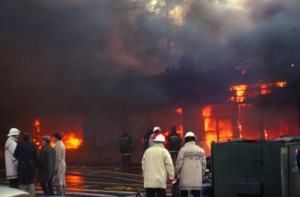Author Interviews, Cancer Research, CDC, Occupational Health / 24.09.2015
Firefighters May Face Increased Risk of Cancer
 MedicalResearch.com Interview with: Robert D. Daniels Ph.D
Division of Surveillance, Hazard Evaluations, and Field Studies
National Institute for Occupational Safety and Health
Cincinnati, Ohio
Medical Research: What is the background for this study?
Dr. Daniels: In 2010, National Institute for Occupational Safety and Health (NIOSH) researchers, with funding assistance from the U.S. Fire Administration, launched a multi-year study to examine whether fire fighters have a higher risk of cancer and other causes of death due to job exposures. Our study was designed to address limitations of previous fire fighter cancer research.
? We included a significantly larger population. With more than 30,000 career fire fighters who served in Chicago, Philadelphia, and San Francisco Fire Departments between 1950 and 2010, it is the largest study of United States fire fighters ever undertaken. In addition, both non-white and female fire fighters are represented.
? We looked not only at deaths from cancer, but also at the diagnosis of certain kinds of cancer, such as testicular and prostate cancer, which have higher survival rates. We also examined other causes of death to better understand the risk for various cancers and illnesses among fire fighters compared to the general public.
? We also examined the relation between cancer and several proxies of exposure, such as the number of fire runs, time spent at fires, and duration of employment of each firefighter (Dahm et al. 2015).
The study was conducted in two parts. The first part was aimed to answer the question: “Is cancer associated with firefighting?” by comparing firefighter cancer risk to that of the general population. The second part focused on the question: “Are higher-exposed firefighters more at risk?” Findings from both parts have been published in the journal, Occupational and Environmental Medicine (Daniels et al. 2014, 2015).
(more…)
MedicalResearch.com Interview with: Robert D. Daniels Ph.D
Division of Surveillance, Hazard Evaluations, and Field Studies
National Institute for Occupational Safety and Health
Cincinnati, Ohio
Medical Research: What is the background for this study?
Dr. Daniels: In 2010, National Institute for Occupational Safety and Health (NIOSH) researchers, with funding assistance from the U.S. Fire Administration, launched a multi-year study to examine whether fire fighters have a higher risk of cancer and other causes of death due to job exposures. Our study was designed to address limitations of previous fire fighter cancer research.
? We included a significantly larger population. With more than 30,000 career fire fighters who served in Chicago, Philadelphia, and San Francisco Fire Departments between 1950 and 2010, it is the largest study of United States fire fighters ever undertaken. In addition, both non-white and female fire fighters are represented.
? We looked not only at deaths from cancer, but also at the diagnosis of certain kinds of cancer, such as testicular and prostate cancer, which have higher survival rates. We also examined other causes of death to better understand the risk for various cancers and illnesses among fire fighters compared to the general public.
? We also examined the relation between cancer and several proxies of exposure, such as the number of fire runs, time spent at fires, and duration of employment of each firefighter (Dahm et al. 2015).
The study was conducted in two parts. The first part was aimed to answer the question: “Is cancer associated with firefighting?” by comparing firefighter cancer risk to that of the general population. The second part focused on the question: “Are higher-exposed firefighters more at risk?” Findings from both parts have been published in the journal, Occupational and Environmental Medicine (Daniels et al. 2014, 2015).
(more…)
